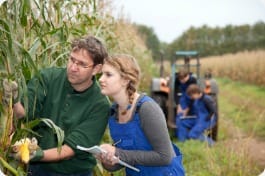Agriculture Teacher Certification

It might come as a surprise, but agriculture education is necessary now more than ever. Our population is growing and with an estimated 9 billion people to feed in 2050, the agriculture industry needs gifted and hardworking youth to be committed to agriculture. Many of these individuals will have their first opportunity to develop a greater understanding and knowledge of agriculture in school.
On This Page…
| What is agriculture teacher certification? |
| What do agriculture teachers do? |
| Why are agriculture teachers important? |
| Career prospects… |
| Find Schools offering teaching certification programs |
The love of this in-depth industry starts with agriculture teachers. They teach students how to use the newest techniques to become environmental stewards and effectively use resources to sustain life without destroying those resources. Teaching agriculture is also more broad and diverse than most people realize. Agriculture is more than just farming; it’s a sustainable way of life and includes teaching students about:
- Agribusiness, which is how to manage a large industrial farm from the growing process to shipping.
- Animal husbandry, including the care, raising, and maintenance of animals that perform agricultural labor as well as provide food sources for people.
- Hard sciences like chemistry and physics, through these subjects students learn the fundamental processes underlying all growth and change in land and animals.
Agriculture teachers must integrate all of this knowledge, and much more, into their education curricula, making agriculture teaching a dynamic and interdisciplinary field.
What is Agriculture Teacher Certification?
Agriculture teachers must be certified in order to teach in public schools and many private schools. Certification is issued on the state level, usually following the completion of an approved state Board of Education exam or college program. In some fields, aspiring teachers can earn bachelor’s degrees in many different subjects. For example, social science teachers can major in history, political science, sociology, geography, etc. However, agriculture teaching is unlike those fields. To become an agriculture teacher, you must have a bachelor’s degree in agriculture or agriculture science.
The National FFA Organization, also known as the Future Farmers of America, was founded in 1928 and has become one of the primary supports for agricultural education in the United States. Agriculture teachers who create or work with a local school chapter of the FFA can take advantage of its many activities and programs, including:
- Degree programs through which students can earn individual degrees
- Grants for program development and scholarships for individual students
- Awards for programs, teachers, and students that honor significant achievements
Bachelor’s degree programs in agriculture and agriculture science are very broad and thorough. In addition to biology and plant science courses, aspiring teachers need to understand and later teach students how to grow farm products, and the animal science courses that involve dairy management and food production. It is also important to study chemistry for use in pest control and horticulture. Those who wish to teach agriculture also need to complete a teacher training program that includes courses in subjects such as pedagogy and educational psychology.
One of the benefits of certification is that it provides professional credibility that is transferrable to other states if an agriculture teacher decides to move. Many states have entered into reciprocity agreements with other states, and will honor a teaching certification from one of those states. This provides significant flexibility and multiple career options for agriculture teachers. Use the teaching certification requirements map to learn more about certification requirements in your state.
What do Agriculture Teachers Do?
Agriculture teachers are unique in that, unlike most teachers, they work in many environments outside the traditional classroom. In a sense, the world truly does become their classroom, as they lead students through hands on activities in greenhouses, at farms and in science labs to teach them the basic principles of topics such as animal husbandry and land management.
The following are some interesting activities that creative agriculture teachers provide to their students:
- Elementary school students can trace the origin of their cafeteria food. Did they serve pizza? What is pizza made of and where does the food come from? Students will have fun figuring out the different ingredients, such as wheat, tomatoes, and cheese, and then planting a small veggie garden to use to make homemade pizza in the classroom. This lesson allows the agriculture teacher to introduce students to different aspects of biology, geography, horticulture, and animal husbandry.
- Middle school students will enjoy building, maintaining, and observing an aquatic habitat to discover how ecosystems work. They can learn about resource management by tracking how the aquatic animals allocate natural resources, what happens to the life cycle over time and how that is affected by the availability of resources, and test the water for minerals. This activity allows students to develop critical thinking skills over time, employ some basic chemistry techniques, and sharpen their knowledge of environments and ecosystems.
- High school students can transform organic materials such as corn oil into biodiesel fuel. They can use laboratory equipment to refine the oil, test its properties, and then use it to fuel farm vehicles such as tractors. Students can then determine the cost of using such a fuel to grow crops and compare it to traditional fuel sources. This activity allows an agriculture teacher to incorporate chemistry, math, economics, and agribusiness into one experiment.
In addition, unlike most of their colleagues who teach other subjects, agriculture teachers also need to manage a wide array of equipment and supervise special programs, specifically the Supervised Agriculture Experience (SAE), an integral component of all agriculture education. This involves experiential education, in which students learn important concepts by working through them. For example, an SAE might take the shape of a small business venture, with students growing and selling a product. It could also mean an internship at a ranch, dairy, or other agriculture-based business, or working with a government agency such as the United States Forest Service. An agriculture teacher must manage all such different student endeavors along with their regular teaching responsibilities.
Finally, agriculture teachers must also perform their share of traditional classroom responsibilities, such as creating lesson plans that fulfill curriculum goals, evaluating student work, participating in school activities, and working with fellow teachers to create a safe and productive school environment. All in all, the different responsibilities keep the job of being an agriculture teacher both lively and interesting.
Why are Agriculture Teachers are Important?
In ancient American civilizations the peanut was an important cultural symbol used in burial services and rendered in bronze sculpture! Since then, scientists like George Washington Carver, who held a master’s degree in agriculture, discovered that peanuts could be used in other more beneficial ways:
- Peanut cultivation revitalizes soil that has been depleted of its nutrients through overuse.
- Peanuts can be used to create ink, soap, and other household products.
- Peanuts provide a cheap source of protein to millions around the world suffering through famine and malnutrition, making the legume a life-saving resource.
Agriculture teachers open many possible doors for their students because of the diversity of the subject. They teach skills that are necessary to human development, including food production, environmental preservation, and resource management. In addition to the valuable vocation of farming, agriculture teachers can inspire their students to pursue many different possible careers.
- Students can continue their studies in college and work for local, state, or federal governments to analyze and create policy on such issues as land use and area economic planning.
- Agriculture students can go on to work with animals as veterinarians, meat inspectors, dairy operators, and farm and ranch managers.
- Many companies hire researchers in areas such as genetics, biochemistry, pharmaceutical development, and the creation of renewable fuels.
- Students can become environmentalists and work for private organizations or government agencies to preserve natural resources. They can also work to restore delicate ecosystems after natural or manmade disasters.
- Students can combine agriculture and an interest in international affairs by working to solve global resource shortages and address crises such as famine, drought, and natural catastrophes that destroy plants and animals, such as disease.
Career Prospects for Agriculture Teachers
Vocational, technical and skills-based education teachers are integral components of any K-12 education program, and agriculture teaching positions are often available. In 2010, some areas of the nation actually experienced a shortage of qualified agriculture teachers. While the federal government does not project much substantial growth in the field, there will continue to be a steady need for agriculture teachers to maintain current levels of agriculture instruction. It is important to remember that agriculture teachers can be hired for many different teaching positions, including home economics and to keep an open mind about the kind of teaching position you wish to pursue.







